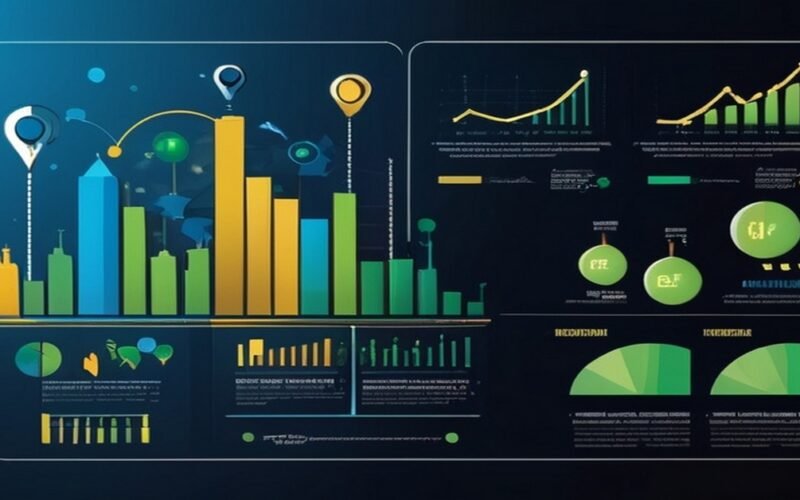Summary: Data visualization is essential for interpreting complex information. This article covers various types of data visualization, such as bar charts, line graphs, and heat maps. It also provides guidance on selecting the right visualization based on data type, comparison goals, audience familiarity, and the balance between clarity and complexity.
Introduction
Data visualization is a powerful tool that transforms raw data into graphical representations, making it easier to understand complex information and identify patterns, trends, and insights.
With the exponential growth of data in today’s digital age, effective visualization techniques have become essential for businesses, researchers, and analysts alike.
This blog will explore various types of data visualization, their unique features, and when to use them.
Why Data visualization Matters
Data visualization plays a crucial role in data analysis by providing a visual context that enhances comprehension.
It allows users to see relationships between variables, observe trends over time, and compare different data sets. Effective visualizations can lead to better decision-making, improved communication of ideas, and a deeper understanding of the underlying data.
Key Takeaways
- Select visualizations that match your data: categorical or numerical for clarity.
- Determine if you need to compare values, trends, or proportions effectively.
- Adjust complexity and style based on your audience’s data familiarity.
- Simpler visualizations often convey insights more clearly than complex designs.
- Different chart types serve unique purposes; choose wisely for accurate representation.
Read More:Best Data visualization Tools for Data Enthusiasts 2024
Common Types of Data visualization
Data visualization is a crucial tool for interpreting and presenting complex data in an accessible format. Various types of data visualizations serve different purposes, allowing users to identify trends, patterns, and insights effectively. Below are some of the most common types of data visualization.
Bar Charts
Bar charts are one of the most common types of data visualization. They use rectangular bars to represent different categories or values. The length of each bar corresponds to its value.
When to Use: Bar charts are ideal for comparing discrete categories or showing changes over time when the number of categories is limited.
Line Charts
Line charts display information as a series of data points connected by straight line segments. They are particularly useful for showing trends over time.
When to Use: Use line charts when you want to visualise continuous data or track changes over intervals, such as sales growth over several months.
Pie Charts
Pie charts represent data as slices of a circular pie. Each slice corresponds to a category’s proportion relative to the whole.
When to Use: Pie charts are best for displaying part-to-whole relationships when you have a limited number of categories (ideally less than six).
Scatter Plots
Scatter plots show the relationship between two variables using Cartesian coordinates. Each point represents an observation in the dataset.
When to Use: Use scatter plots to identify correlations or patterns between two continuous variables, such as height versus weight.
Heat Maps
Heat maps use colour gradients to represent data values across two dimensions. They are effective for visualising complex datasets.
When to Use: Heat maps are useful for displaying relationships in large datasets, such as website traffic by hour and day.
Area Charts
Area charts are similar to line charts but fill the area beneath the line with colour, emphasising the magnitude of values over time.
When to Use: Area charts are effective for showing cumulative totals over time or comparing multiple trends simultaneously.
Histograms
Histograms are used to represent the distribution of numerical data by dividing it into bins or intervals and counting the number of observations in each bin.
When to Use: Use histograms to visualise frequency distributions and understand how data is spread across different ranges.
Box-and-Whisker Plots
Box-and-whisker plots summarise a dataset’s distribution using five summary statistics (minimum, first quartile, median, third quartile, maximum).
When to Use: These plots are excellent for comparing distributions across different groups and identifying outliers in your data.
Gantt Charts
Gantt charts are used in project management to illustrate project schedules. They show tasks along a timeline with bars representing their duration.
When to Use: Gantt charts are beneficial for tracking project progress and managing timelines effectively.
Treemaps
Treemaps display hierarchical data using nested rectangles. Each rectangle’s size represents a quantitative value related to that category.
When to Use: Treemaps are useful for visualising proportions within hierarchical structures, such as organisational charts or budget allocations.
Donut Charts
Donut charts are similar to pie charts but have a hole in the centre. They display proportions but allow for additional information in the centre space.
When to Use: Donut charts can be used when you want a cleaner look than pie charts while still displaying part-to-whole relationships.
Bullet Graphs
Bullet graphs provide a way to compare performance against goals using bars and markers on a single axis.
When to Use: These graphs are ideal for displaying progress toward specific targets or benchmarks in a compact format.
Word Clouds
Word clouds visually represent text data where the frequency of each word determines its size in the graphic.
When to Use: Word clouds are great for summarising qualitative data or highlighting key themes from textual sources like survey responses or social media posts.
Infographics
Infographics combine graphics with text and statistics to convey information quickly and clearly.
When to Use: Infographics are effective for storytelling with data, making complex information more digestible for audiences without technical backgrounds.
Dashboards
Dashboards compile multiple visualizations into one interface, providing an overview of key metrics and performance indicators at a glance.
When to Use: Dashboards are useful for monitoring real-time performance across various aspects of business operations or project management.
Choosing the Right visualization Type
Choosing the right type of data visualization is essential for effectively communicating insights and findings. Here are key considerations and types of visualizations to help guide your selection.
Data Type
When selecting a visualization, first identify whether your data is categorical or numerical. Categorical data consists of distinct groups or categories, such as names or labels, while numerical data involves measurable quantities like sales figures or temperatures. This distinction guides you toward the most suitable visualization types for effective communication.
Comparison Needs
Understanding your comparison needs is essential for choosing the right visualization. Decide if your goal is to compare values across categories, show trends over time, or illustrate part-to-whole relationships. Each objective requires different visual formats; for instance, bar charts work well for comparisons, while line graphs excel at depicting trends.
Audience
Tailoring your visualization style to your audience’s familiarity with data analysis is crucial. If your audience consists of non-experts, opt for straightforward designs that emphasise clarity and simplicity. Conversely, if presenting to a specialised audience, you can utilise more complex visualizations that incorporate detailed insights and advanced analytical elements.
Complexity
Balancing clarity with complexity in your visualizations is vital for effective communication. While intricate designs can convey more information, they may overwhelm viewers and obscure key messages. Simpler visualization is often communicating insights more clearly, allowing the audience to grasp essential points without unnecessary distractions or confusion.
Conclusion
Data visualization is an essential skill in today’s information-driven world. By understanding various types of visualizations and their appropriate applications, individuals can communicate insights more effectively and make informed decisions based on complex datasets.
Whether you’re analysing sales trends or presenting research findings, choosing the right visualization type can enhance understanding and engagement with your audience.
Frequently Asked Questions
What Is Data visualization?
Data visualization is the graphical representation of information and data using visual elements like charts, graphs, and maps. It helps users understand complex datasets by highlighting trends, patterns, and insights that might be difficult to discern from raw data alone.
How Do I Choose the Right Type of visualization?
Choosing the right type depends on your data type (categorical vs. numerical), what you want to compare (values vs. trends), your audience’s familiarity with data analysis, and how complex your message is. Simpler visualizations often communicate more effectively than intricate ones.
Can I Use Multiple Types of visualizations Together?
Yes! Combining different types of visualizations within dashboards can provide comprehensive insights into your data by showcasing various aspects simultaneously—such as trends over time alongside part-to-whole relationships—enhancing overall understanding and decision-making capabilities.




